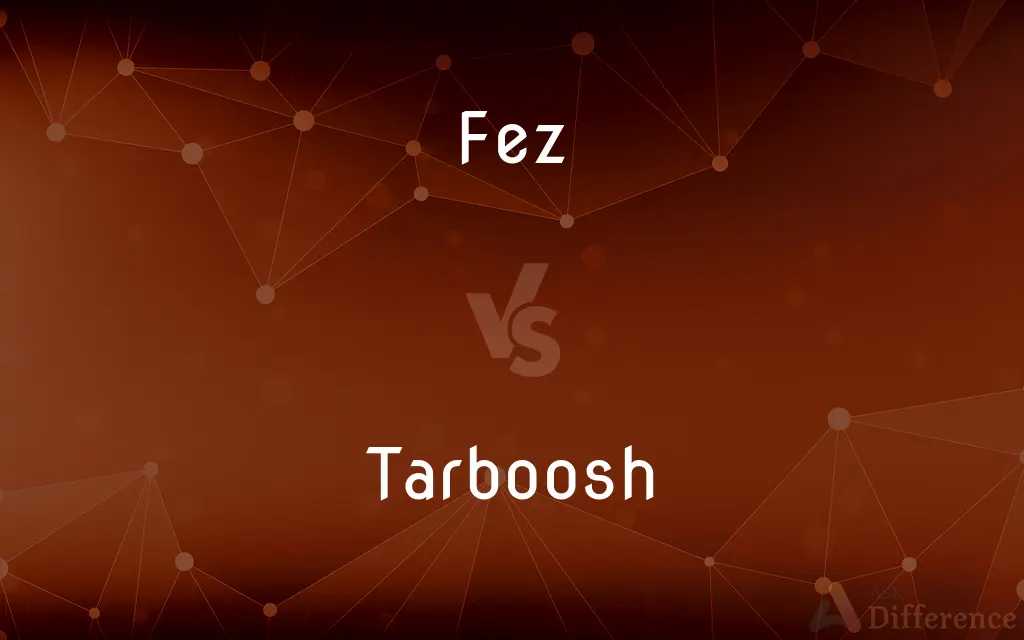Fez vs. Tarboosh — What's the Difference?
Edited by Tayyaba Rehman — By Maham Liaqat — Updated on March 27, 2024
A fez is a felt headdress in the shape of a truncated cone, known for its red color and tassel, similar to the tarboosh but culturally specific to different regions.

Difference Between Fez and Tarboosh
Table of Contents
ADVERTISEMENT
Key Differences
The fez, characterized by its red color, cylindrical shape, and black tassel, is traditionally associated with the Ottoman Empire and has become a symbol of various Eastern cultures. Whereas the tarboosh, essentially identical in physical appearance to the fez, is more specifically tied to Egyptian and broader North African cultural identities. While the terms are often used interchangeably due to their similar appearances, their cultural connotations differ.
In terms of history, the fez became widely adopted across the Ottoman Empire in the 19th century as part of modernization efforts, signifying a move away from the traditional turban. On the other hand, the tarboosh has roots in Ottoman-influenced Egypt and North Africa, where it was adopted into local dress codes, blending with indigenous styles and signifying a form of local identity under Ottoman influence.
Culturally, the fez is associated with a wide range of territories once under Ottoman rule, symbolizing a connection to the empire's legacy. The tarboosh, however, holds a more specific place in North African identity, representing a blend of Ottoman influence and local tradition, particularly in countries like Egypt.
While both headgears have seen a decline in everyday use, influenced by changing fashion and political shifts, the fez occasionally appears in traditional ceremonies or as part of cultural heritage expressions. Conversely, the tarboosh is often seen in historical contexts or as a symbol of cultural pride in specific North African communities.
The production and craftsmanship of both the fez and tarboosh remain a testament to traditional hat-making skills. However, artisans who specialize in these headdresses often emphasize the cultural heritage and historical significance of their craft, differentiating between the two based on regional traditions and historical context.
ADVERTISEMENT
Comparison Chart
Cultural Origin
Ottoman Empire, broadly adopted in Eastern cultures.
Specifically Egyptian and North African cultures.
Historical Significance
Symbol of Ottoman modernization efforts.
Represents a blend of Ottoman and local traditions.
Physical Appearance
Red felt, truncated cone shape, with a black tassel.
Identical to the fez in physical appearance.
Usage
Worn in traditional ceremonies, less common today.
Often seen in historical or cultural contexts.
Symbolism
Connection to the Ottoman Empire's legacy.
Specific to North African identity and heritage.
Compare with Definitions
Fez
A symbol of Eastern and Ottoman cultural heritage.
The fez is often seen in ceremonies celebrating Ottoman history.
Tarboosh
Less commonly worn today, but remains a symbol of pride.
On national holidays, some choose to wear a tarboosh to honor their ancestors.
Fez
A red, cylindrical hat with a black tassel, originating from the Ottoman Empire.
He wore a traditional fez to the cultural festival.
Tarboosh
Emblematic of Egyptian and broader North African identity.
The tarboosh is a proud symbol of North African culture.
Fez
Once a part of official dress codes across the Ottoman territories.
Ottoman officials were required to wear a fez in the 19th century.
Tarboosh
A felt headdress of North African origin, similar to the fez but with specific cultural ties.
At the wedding, many guests wore a tarboosh as a nod to their heritage.
Fez
Represents a shift from traditional turbans in Ottoman society.
The adoption of the fez marked a modernization movement within the empire.
Tarboosh
Signifies a local adaptation of Ottoman influence.
The tarboosh reflects how Ottoman traditions were woven into local customs.
Fez
Associated with traditional craftsmanship.
Artisans who make fezes are preserving a centuries-old tradition.
Tarboosh
Crafted with traditional techniques specific to the region.
Local artisans continue the craft of making tarbooshes by hand.
Fez
A man's brimless felt cap in the shape of a flat-topped cone, usually colored red and adorned with a silk tassel, once widely worn in the Ottoman Empire and other regions with Muslim populations and still worn today in some Muslim countries. Also called tarboosh.
Tarboosh
See fez.
Fez
A felt hat in the shape of a truncated cone, having a flat top with a tassel attached.
Tarboosh
A red felt or cloth cap with a tassel, worn in the Arab world; a fez.
Fez
A felt or cloth cap, usually red and having a tassel, - a variety of the tarboosh. See Tarboosh.
Tarboosh
A red cap worn by Turks and other Eastern nations, sometimes alone and sometimes swathed with linen or other stuff to make a turban. See Fez.
Fez
A city in north central Morocco; religious center
Tarboosh
A felt cap (usually red) for a man; shaped like a flat-topped cone with a tassel that hangs from the crown
Fez
A felt cap (usually red) for a man; shaped like a flat-topped cone with a tassel that hangs from the crown
Common Curiosities
Why did the fez become a symbol of the Ottoman Empire?
It was adopted in the 19th century as part of modernization efforts, symbolizing a move away from the turban.
Can anyone wear a fez or tarboosh today?
While less common, they are worn during traditional ceremonies or as cultural symbols, respecting their cultural significance.
Are the fez and tarboosh the same?
They are physically identical but differ in cultural and regional associations.
What does the tarboosh represent in North African culture?
It symbolizes a blend of Ottoman influence with local tradition and identity, especially in Egypt and surrounding areas.
Do the fez and tarboosh have different colors or designs?
They are generally red with a black tassel but may vary slightly in shape or shade according to local traditions.
Is there a difference in how the fez and tarboosh are made?
The crafting techniques are similar, but artisans may emphasize traditional methods and cultural meanings specific to their region.
How do the fez and tarboosh differ in symbolism?
The fez symbolizes the Ottoman Empire's legacy, while the tarboosh has more specific associations with North African identity.
What led to the decline in the popularity of the fez and tarboosh?
Changing fashion trends and political shifts away from Ottoman influence contributed to their decline.
Are the fez and tarboosh still made by artisans today?
Yes, artisans continue to produce them, often emphasizing the cultural heritage and craftsmanship involved.
Were the fez and tarboosh ever part of official dress codes?
Yes, in the Ottoman Empire and its influenced regions, they were once part of the official dress.
What occasions might warrant wearing a fez or tarboosh?
They are often worn at weddings, cultural festivals, and national celebrations.
Has the significance of the fez and tarboosh changed over time?
Yes, their significance has evolved from everyday wear to symbols of cultural identity and heritage.
Is the tarboosh only worn in Egypt?
While strongly associated with Egypt, it's also part of the broader North African cultural heritage.
How do modern perceptions of the fez and tarboosh differ?
Perceptions vary, but both are viewed with cultural respect and nostalgia, though they may also be seen as symbols of historical periods.
Are there contemporary uses for the fez and tarboosh?
Beyond traditional uses, they occasionally appear in fashion and as symbols of cultural pride.
Share Your Discovery

Previous Comparison
Gorge vs. Gouge
Next Comparison
Practical vs. InventiveAuthor Spotlight
Written by
Maham LiaqatEdited by
Tayyaba RehmanTayyaba Rehman is a distinguished writer, currently serving as a primary contributor to askdifference.com. As a researcher in semantics and etymology, Tayyaba's passion for the complexity of languages and their distinctions has found a perfect home on the platform. Tayyaba delves into the intricacies of language, distinguishing between commonly confused words and phrases, thereby providing clarity for readers worldwide.














































